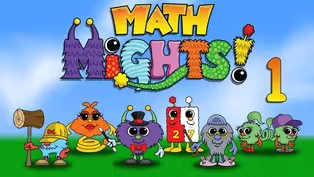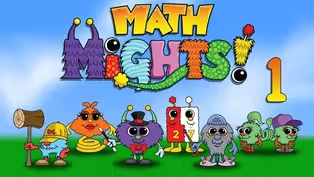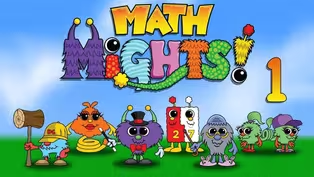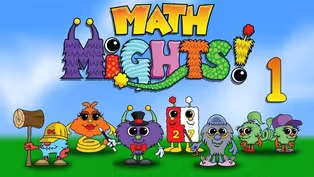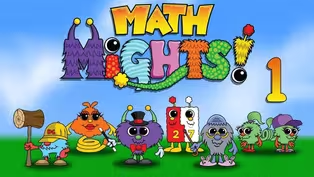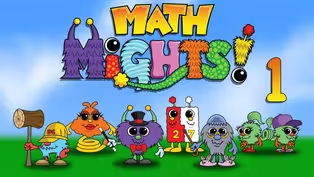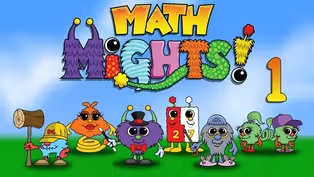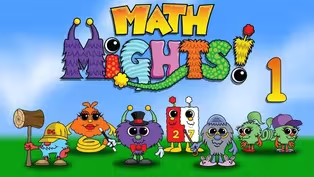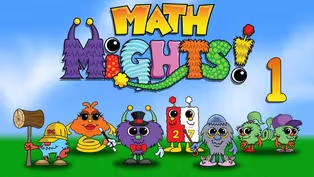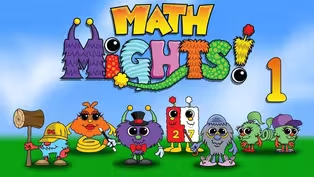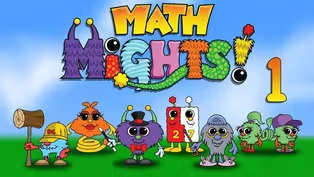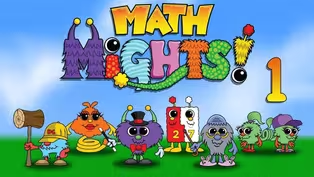Math Mights
Decompose/Compose to Add
Season 3 Episode 306 | 16m 6sVideo has Closed Captions
Join Mrs. Markavich for a missing addend word problem.
Join Mrs. Markavich for a missing addend word problem with her friend Professor Barble. Next get ready to have some fun with D.C. adding 2 digit-numbers to a 1 digit number by making a friendly decade number!
Problems playing video? | Closed Captioning Feedback
Problems playing video? | Closed Captioning Feedback
Math Mights is a local public television program presented by Detroit PBS
Math Mights
Decompose/Compose to Add
Season 3 Episode 306 | 16m 6sVideo has Closed Captions
Join Mrs. Markavich for a missing addend word problem with her friend Professor Barble. Next get ready to have some fun with D.C. adding 2 digit-numbers to a 1 digit number by making a friendly decade number!
Problems playing video? | Closed Captioning Feedback
How to Watch Math Mights
Math Mights is available to stream on pbs.org and the free PBS App, available on iPhone, Apple TV, Android TV, Android smartphones, Amazon Fire TV, Amazon Fire Tablet, Roku, Samsung Smart TV, and Vizio.
Providing Support for PBS.org
Learn Moreabout PBS online sponsorshipMore from This Collection
Video has Closed Captions
Join Mrs. Markavich for a missing addend word problem with Professor Barble! (16m 5s)
Adding Tens-Tens and Ones-Ones
Video has Closed Captions
Join Mrs. Markavich for a missing addend word problem with Professor Barble! (15m 35s)
Write Equations to Match the Strategy
Video has Closed Captions
Join Mrs. Markavich for a missing addend word problem with Professor Barble. (16m 2s)
Video has Closed Captions
Join Mrs. Markavich for a subtraction word problem with Professor Barble. (15m 59s)
Add 2-Digit Numbers & Write Equations
Video has Closed Captions
Join Mrs. Markavich for a word problem with her friend Professor Barble! (15m 59s)
Comparing Numbers Different Ways
Video has Closed Captions
Value Pak shows you the different ways to compare 2-digit numbers. (15m 44s)
Video has Closed Captions
Join Mrs. Markavich for a word problem with her friend Professor Barble! (15m 59s)
Video has Closed Captions
Join Mrs. Markavich for a word problem with her friend Professor Barble! (15m 59s)
Decompose/Compose #'s Different Ways
Video has Closed Captions
We show you different ways to decompose and compose 2-digit numbers! (15m 59s)
Video has Closed Captions
Join Mrs. Markavich & Dotson to talk about numbers with the Counting Buddy Senior! (16m)
Video has Closed Captions
Join Mrs. Markavich & Dotson for a Numeracy Talk with the Counting Buddy Senior (16m)
Video has Closed Captions
Join Mrs. Markavich for Numeracy Talk with Dotson working on conservation to 20. (16m)
Providing Support for PBS.org
Learn Moreabout PBS online sponsorship(playful music) - [Children] Math Mights!
- Hey, first grade Math Mights.
Mrs. Markovich here with you again.
Let's go ahead and check out our plan for today and all of the exciting things we're going to be doing in math.
The first thing we'll be doing are some word problems with my friend, Professor Barble.
And then we'll be adding two-digit and one-digit numbers.
I always like to start by warming up our math brain.
And we have Professor Barble here today and he loves to conquer word problems and he's going to be helping us out.
Let's check him out.
(dramatic music) Hey, Professor Barble.
Thanks for coming to help us out today.
Professor Barble is a Math Might and he lives in Mathville and he loves to solve word problems.
And if you just slow down and he pushes on his cap, poof, out pops all of these really cool math tools that will help him to solve math problems and word problems.
Let's talk about a visual model.
You probably are wondering, what is a visual model?
A visual model is sometimes known as a model drawing, a unit bar, a tape diagram, or a bar model.
The next thing you want to know about a visual model is that it is used for reading comprehension strategies for word problems.
And finally, drawing a visual model helps to visualize the strategies and understand what the word problem is doing.
Here you can see something that I would use in my own first grade classroom.
This is a visual model.
You can see the problem at the top right here with the word problem and some more information on this paper.
Let's take a look at this problem.
It says, there are 12 coats on the rack.
Seven of them were pink and the rest were blue.
How many blue coats were on the rack?
My friend Molly says, "I think we maybe should add to solve this problem."
Han says, "Wait, or do we subtract?"
Well, here comes Professor Barble and he says, "Whoa, Molly and Han, slow down.
I've got some steps that we need to follow."
Let's take a look at them as we work through this word problem.
Our first step is to read the entire problem and put it into chunks.
Chunking is grouping information.
So let's read it.
I'll read it and I'll have you echo me and we'll chunk it as we go.
Here we go.
There were 12 coats on the rack.
Chunk it.
Seven of them were pink.
Chunk it.
And the rest were blue.
Chunk it.
How many blue coats were on the rack?
Chunk it.
The next step, step two, is to rewrite the question in a sentence form with a blank space for the answer.
So you can see it says, there were hmm blue coats on the rack.
Step number three is to determine the who or the what in the problem.
So let's take a look at mine.
I don't have a who in mine, but I do have a what, and the what are the coats.
Step number four is for us to draw the unit bar.
Now, remember, I told you when we started this a few episodes ago, that I was going to make it a little more tricky as we go along.
And you can see my unit bar doesn't have anything filled in it, but we'll figure it out together.
Step five is to check when each chunk part is added.
So we're going to do that part together and we're going to do it on mine that's in front of me.
So let's solve this together.
It says, there were 12 coats on the rack.
There's my first portion of information.
There were 12 coats on the rack.
That sounds like the whole number.
So I know that the whole number is going to go at the end of my unit bar.
Let's write a 12 right there, and then let's make sure we go up and we check it off.
The next part says, seven of them were pink.
So I know I'm going to add that part to my unit bar, but I wanna read a little more before I add it.
It says, and the rest were blue.
Hmm, that seven parts seems like a big number, so I'm not going to cut this directly in half.
I'm going to make this part a little bit bigger like this.
I'm going to write the number seven inside of the unit bar, seven, and then I'm going to write the word pink up here, because it's always important to label our work when we're doing math.
Then I'm going to go back up here and I'm going to check it off.
So make sure you check that you added that seven in.
And then it says, and the rest were blue.
So this is the portion over here that must be blue, but, hmm, they didn't tell me what part was blue.
So this right here is where I'm going to add my question mark and I'm going to label it blue, and then I'm gonna go up and I'm gonna make sure that I check that.
Now, the last part says, how many blue coats were on the rack?
That's this part here.
Hmm, I have to solve that part.
I'm gonna check it off.
The next thing I have to do is compute and solve the problem.
And my friend is saying, "Oh, now I see what the problem is asking."
I'm going to have to subtract because I don't know this part.
I know the whole number and I know the pink part, but I don't know the blue part.
So I'm going to put the whole number 12, I'm going to put a minus or subtraction sign, I'm going to take away the seven, the pink part, and that will give me my question mark right here.
And I know that 12 minus seven equals five.
So I'm going to put the five in here, but we're not quite done.
We have one part left.
Our last step in our word problem is to write the answer up in our sentence.
So it says, there were hmm blue coats on the rack.
We're going to put that five right here.
And I know that 12 minus seven equals five.
There were five blue coats on the rack.
That was some great thinking, Math Mights.
Now we're going to talk about our I can statement for the day.
I can add a two-digit number to a one-digit number by decomposing and composing.
Ooh, let's look at these 10-frames.
How many do you see?
How do you see them?
Well, my first friend Molly says, "40.
I see 40."
I see three 10-frames filled, 10, 20, 30, so that is 30, then I see five red counters and five yellow counters.
So I know that 30 plus five and five is 40.
Great thinking, Molly.
So now we've changed it just a little bit.
Let's take a look at it.
How many do you see, and how do you see them?
My friend Han says, "I see 50.
I see one more 10-frame filled."
10, 20, 30, 40, and then I have another 10-frame right here, so I know that 40 and 10 more makes 50.
Wow, great thinking, Han.
I'm changing one last time on you, so I want your brain camera to take a quick picture of it.
Ready?
Here we go.
How many do you see?
And how do you see them?
Well, my friend Molly says, "Easy, 53.
I see four 10-frames filled with red."
10, 20, 30, 40, Then I see a 10-frame filled with five red and five yellow, so I know that 40 and 10 more is 50, and there are three left, so I can count on 50, 51, 52, 53.
Great job getting your brains ready with 10-frames.
Now let's take a look at how to out the sum for eight plus 47.
And Molly says, "Ooh, I know what we can do.
I think we can do 47 plus one, plus one, oh, plus one, Molly, this is taking your really long time, plus one."
So 48, 49, 50, 51, 52, 53, 54, 55.
Wow, what are you wondering?
That really took a long time.
My friend Han says, "No, no, no, no.
I think we should use D.C. to help with this problem."
Hey, D.C., come and help us.
(bright music) Here's my friend D.C. and he lives in Mathville too and he loves friendly numbers and he likes to decompose them to make a 10.
Now let's look at D.C. decomposing eight plus 47.
When he does it, it turns into a number bond of five and three.
How does he do that?
Let's take a look at how D.C. can help us decompose this and make a friendly number a 10.
My friend D.C. sees this.
He sees 10, 20, 30, 40, and then he sees the seven here, and then he sees eight here and he says, "No, no, no" and he wears a hard hat and has a mallet and he likes to decompose those numbers and he wants to fill this 10-frame.
So he's going to use his mallet and decompose those and move them up here like this.
So now I've taken that eight and I've made it into two parts.
I have five and I have three and I'm going to grab those together.
And I know now I have 50 plus the five that are in this 10-frame equal 55.
I think we should try another problem with D.C. 45 plus seven.
Huh, I wonder what he'll do.
Do you think he'll turn that 45 into a 50 or the seven into a 10 because they're both friendly numbers?
Let's take a look and see how D.C. does it.
Here we go D.C. Bonk!
He turns that seven into five and two.
I wonder how he did that.
Let's take a look at what I have in front of me.
You can see I have 10, 20, 30, 40, 45, and then I have seven.
One, two, three, four, five, six, seven.
Ooh, D.C. does not like the way this looks.
He likes everything organized and put together in a 10.
And I think we're going to use friend D.C. to help us make a 10.
He's going to decompose the seven.
Bonk, bonk, bonk, bonk, bonk.
And we're gonna move them up here.
Now, I made a nice 10 with my friend D.C., and then I have some down here.
So I'm going to take my seven and show five and two.
I'm gonna go over and grab that 45, and now I have 50 plus two equals 52.
Thanks for helping out, D.C.
I wonder if that's the only way that D.C. can solve this problem.
Do you think you can do it another way?
When we started, we said 45 and seven were both friendly numbers.
Let's check it out.
Hey, D.C., help us out again.
Bonk!
He bonks that number, and now I see 42 and three.
Huh?
I wonder how we're gonna solve this one.
I definitely think we need to take a look at my board and see if we can use D.C. to help us with this.
Come on over.
You can see I'm here.
I have 10, 20, 30, 45, and then I have the seven.
One, two, three, four, five, six, seven.
This time when D.C. decomposes, because remember, he doesn't like how this is organized.
He wants a 10.
This time he decides to bonk my 45 and he gives it a big huge bonk because there are some empty spaces down here in our 10-frame.
We have three spaces.
So he bonks, and then we move down.
One, two, three.
Whoa, look at this.
When I decompose the 45, now I have 10, 20, 30, 40, 41, 42.
I'm gonna write that number here and down here.
This is where I moved the three right here.
This time, I'm going to take my three and grab that seven.
And my equation is going to look a little different than it did last time.
I'm going to write 42 plus 10 equals, let's count it out.
10, 20, 30, 40, 50, go back up and count, 51, 52.
My answer is 52.
Both ways that we solved this, we got the same answer.
It's so great that we had D.C. with us to help us solve this.
I don't know if I could have done it without him.
Thanks for helping me be so much more efficient, D.C. Now it's your turn to play a game.
It's called Solve with D.C. just like we did today.
Thanks so much for coming to do math with me today, Math Mights.
I'll see you next time.
(bright music) (upbeat music) - [Child] Sis4teachers.org.
(air whooshes) Changing the way you think about math.
(bright music) - [Narrator] This program is made possible with funding from the Michigan Department of Education, Governor's Education Emergency Funds, the State of Michigan, and by viewers like you.
(upbeat music)


- Home and How To

Hit the road in a classic car for a tour through Great Britain with two antiques experts.










Careers that Work

Support for PBS provided by:
Math Mights is a local public television program presented by Detroit PBS
